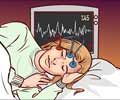
‘Parameters quantifying desaturations based on their characteristic properties have a significant association with impaired vigilance and ability to sustain attention.’
Tweet it Now
Obstructive sleep apnea (OSA) is one of the most prevalent sleep disorders, affecting more than 20% of the adult population in Western countries. OSA is attributed to daytime symptoms of shortened daytime sleep latencies as well as chronic fatigue and sleepiness. Furthermore, OSA is related to poor neurocognitive performance and inability to sustain attention.Neurocognitive disorders cover the domains of learning and memory, language, executive functioning and complex attention, among others. One test assessing neurocognitive performance is the psychomotor vigilance task (PVT), which evaluates the domain of complex attention by measuring repeated responses to visual stimuli, thus assessing a person’s ability to sustain attention.
The researchers investigated the role of conventional and novel polysomnography parameters in predicting PVT performance in a sample of 743 OSA patients. The patients completed the PVT test in the evening before undergoing a polysomnography.
All polysomnography recordings were scored manually by experienced sleep technicians who regularly participate in scoring concordance activities. All apneas, hypopnoeas and desaturations were scored manually in accordance with established guidelines.
The researchers found that their novel parameters describing the severity of intermittent hypoxaemia, i.e. oxygen desaturation during sleep, are significantly associated with an increased risk of impaired PVT performance, whereas conventional OSA severity and sleep fragmentation metrics are not.
Advertisement
According to the researchers, parameters quantifying desaturations based on their characteristic properties have a significant association with impaired vigilance and ability to sustain attention. Furthermore, an increase in the apnea-hypopnoea index or the oxygen desaturation index does not significantly elevate the odds of having impaired PVT performance.
Advertisement
Source-Eurekalert















